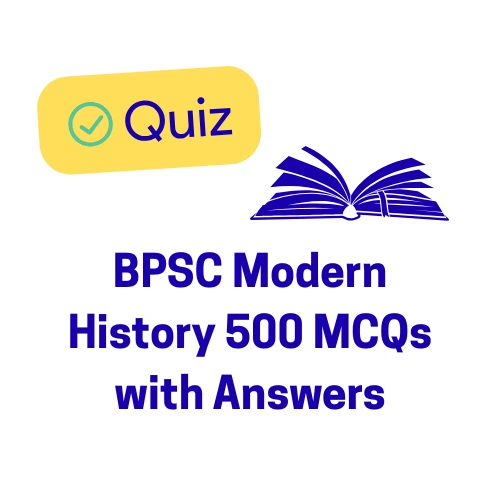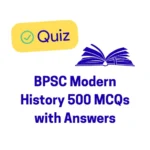BPSC Modern History Part 8 (500 MCQs) focus on the Extremism – Rise of Extremism (1905-1907), Swadeshi – Partition of Bengal and Swadeshi Movement, and Muslim League, Surat Split, and Morley-Minto Reforms.
BPSC Modern History Part 8 (500 MCQs)
Section R: Rise of Extremism (1905-1907)
Q211. Which event is considered the primary catalyst for the rise of the Extremist wing within the Indian National Congress (INC)?
(A) The failure of the Moderates’ methods.
(B) Lord Curzon’s policies, particularly the Partition of Bengal.
(C) The Russo-Japanese War (1904-05), which exposed European military weakness.
(D) The rise of revolutionary terrorism.
(E) More than one of the above
Q212. The Extremists aimed for Swaraj, which they interpreted as:
(A) Self-government within the British Empire (Dominion Status).
(B) Complete independence from foreign rule (Absolute Swaraj).
(C) Political and administrative reforms.
(D) Self-rule under the supervision of the Viceroy.
Q213. Which trio of leaders were collectively known as ‘Lal-Bal-Pal’ and formed the core leadership of the Extremist movement?
(A) Lala Hardayal, Bal Gangadhar Tilak, Prafulla Chaki
(B) Lala Lajpat Rai, Bal Gangadhar Tilak, Bipin Chandra Pal
(C) Lala Lajpat Rai, Bhagat Singh, Bipin Chandra Pal
(D) Aurobindo Ghosh, Bal Gangadhar Tilak, Bipin Chandra Pal
Q214. The concept of ‘Fourfold Swadeshi’ (Swadeshi, Boycott, National Education, and Swaraj) was the program advocated by which leader?
(A) G. K. Gokhale
(B) Surendranath Banerjee
(C) Bipin Chandra Pal
(D) Aurobindo Ghosh
Q215. Which Extremist leader founded the newspapers ‘Kesari’ (Marathi) and ‘Mahratta’ (English)?
(A) Bipin Chandra Pal
(B) Bal Gangadhar Tilak
(C) Lala Lajpat Rai
(D) Aurobindo Ghosh
BPSC Modern History Part 8 (500 MCQs)
Q216. Bal Gangadhar Tilak popularized which two festivals in Maharashtra to instill a spirit of nationalism and unite the people?
Durga Puja
Ganesh Festival
Shivaji Festival
Holi
(A) 1 and 2 only
(B) 2 and 3 only
(C) 1 and 3 only
(D) 3 and 4 only
Q217. Who gave the famous slogan ‘Swaraj is my birthright, and I shall have it’?
(A) Lala Lajpat Rai
(B) Bipin Chandra Pal
(C) Bal Gangadhar Tilak
(D) Aurobindo Ghosh
Q218. Who was famously known as the ‘Lion of Punjab’ (Punjab Kesari)?
(A) Ajit Singh
(B) Lala Lajpat Rai
(C) Bhagat Singh
(D) Bal Gangadhar Tilak
Q219. The Extremist leaders proposed that the struggle for Swaraj should be fought by adopting which method(s)?
(A) Petitioning and deputations to the British Parliament.
(B) Non-violent passive resistance, Swadeshi, and Boycott.
(C) Direct political participation and lobbying.
(D) Judicial appeals and legislative council participation.
Q220. Who wrote the book ‘The Arctic Home in the Vedas’, arguing for a polar origin of the Aryans?
(A) Swami Vivekananda
(B) Aurobindo Ghosh
(C) B. G. Tilak
(D) Dayananda Saraswati
Section S: Partition of Bengal and Swadeshi Movement
Q221. The Partition of Bengal was officially announced and implemented in which year?
(A) 1903
(B) 1904
(C) 1905
(D) 1907
Q222. Who was the Viceroy responsible for the Partition of Bengal, claiming it was for administrative convenience?
(A) Lord Minto
(B) Lord Curzon
(C) Lord Hardinge II
(D) Lord Ripon
Q223. What was the real motive behind the Partition of Bengal, according to nationalist leaders?
(A) To improve communication and administration in the vast province.
(B) To curb the growing nationalist movement in Bengal by dividing the people along communal lines.
(C) To create a separate Muslim-majority province for better governance.
(D) To shift the capital from Calcutta to Delhi.
Q224. The Swadeshi and Boycott movement was formally launched following the INC’s sanction in which session?
(A) Calcutta Session, 1906
(B) Benaras Session, 1905
(C) Surat Session, 1907
(D) Lucknow Session, 1916
Q225. On the day the Partition of Bengal was enforced (October 16, 1905), the day was observed as:
(A) National Protest Day
(B) Raksha Bandhan Day (as a symbol of unity)
(C) Day of Mourning
(D) More than one of the above
BPSC Modern History Part 8 (500 MCQs)
Q226. Which of the following was/were the feature(s) of the Swadeshi Movement?
Boycott of British goods and institutions.
Promoting indigenous industries and goods.
Establishment of National Schools and Colleges.
(A) 1 and 2 only
(B) 2 and 3 only
(C) 1 and 3 only
(D) 1, 2, and 3
Q227. Who played a key role in the establishment of the National Council of Education in 1906 to organize a system of education on national lines?
(A) Aurobindo Ghosh
(B) Rabindranath Tagore
(C) Satish Chandra Mukherjee
(D) All of the above
Q228. Who composed the famous song ‘Amar Sonar Bangla’ (My Golden Bengal), which became an inspiring theme song for the Swadeshi movement (and later the national anthem of Bangladesh)?
(A) Bankim Chandra Chatterjee
(B) Kazi Nazrul Islam
(C) Rabindranath Tagore
(D) Dwijendralal Roy
Q229. Which Moderate leader founded the Servants of India Society in 1905, but initially disagreed with the Extremists’ call for an all-India Boycott movement?
(A) Surendranath Banerjee
(B) G. K. Gokhale
(C) Pherozeshah Mehta
(D) Dadabhai Naoroji
Q230. The movement’s failure to convert the boycott into an effective movement was mainly due to:
(A) Lack of a comprehensive organization.
(B) Government repression and the arrest of leaders.
(C) The split between Moderates and Extremists.
(D) Lack of support from the peasant class.
(E) More than one of the above
Section T: Muslim League, Surat Split, and Morley-Minto Reforms
Q231. The All India Muslim League was formed in 1906 at Dacca (Dhaka). Who was its first President?
(A) Nawab Salimullah of Dacca
(B) Aga Khan III
(C) Muhammad Ali Jinnah
(D) Syed Ahmed Khan
Q232. The main objective behind the formation of the Muslim League was:
(A) To demand Purna Swaraj for Muslims.
(B) To protect and advance the political rights and interests of the Muslims in India.
(C) To launch a united front with the INC against the British.
(D) To advocate for the Partition of India.
Q233. The division of the INC into Moderates and Extremists (Surat Split) occurred in which year?
(A) 1905
(B) 1906
(C) 1907
(D) 1909
Q234. The Surat session of the INC (1907) was presided over by:
(A) Dadabhai Naoroji
(B) Dr. Rash Behari Ghosh
(C) Bal Gangadhar Tilak
(D) G. K. Gokhale
Q235. The immediate cause for the Surat Split was the disagreement over which issue?
(A) The policy towards the Revolutionary activities.
(B) The scope of the Boycott movement and the election of the INC President.
(C) The demand for Dominion Status.
(D) The rejection of the Swadeshi movement.
BPSC Modern History Part 8 (500 MCQs)
Q236. The Indian Councils Act of 1909 is also known as the:
(A) Montagu-Chelmsford Reforms
(B) Regulating Act
(C) Minto-Morley Reforms
(D) Pitt’s India Act
Q237. The most controversial and detrimental provision of the Minto-Morley Reforms (1909) was the introduction of:
(A) Separate electorate for depressed classes.
(B) Separate electorate for Muslims.
(C) Transfer of power to the elected Indian representatives.
(D) Provincial Autonomy.
Q238. Who was the Viceroy and who was the Secretary of State for India associated with the Reforms of 1909?
(A) Lord Minto (Viceroy) and John Morley (Secretary of State)
(B) Lord Morley (Viceroy) and Lord Minto (Secretary of State)
(C) Lord Chelmsford (Viceroy) and Edwin Montagu (Secretary of State)
(D) Lord Hardinge II (Viceroy) and Lord Crewe (Secretary of State)
Q239. The capital of India was officially transferred from Calcutta to Delhi in which year?
(A) 1905
(B) 1909
(C) 1911
(D) 1916
Q240. The announcement of the annulment of the Partition of Bengal was made at which grand event?
(A) Surat Session, 1907
(B) Delhi Durbar, 1911
(C) Lucknow Pact, 1916
(D) Lahore Session, 1929

